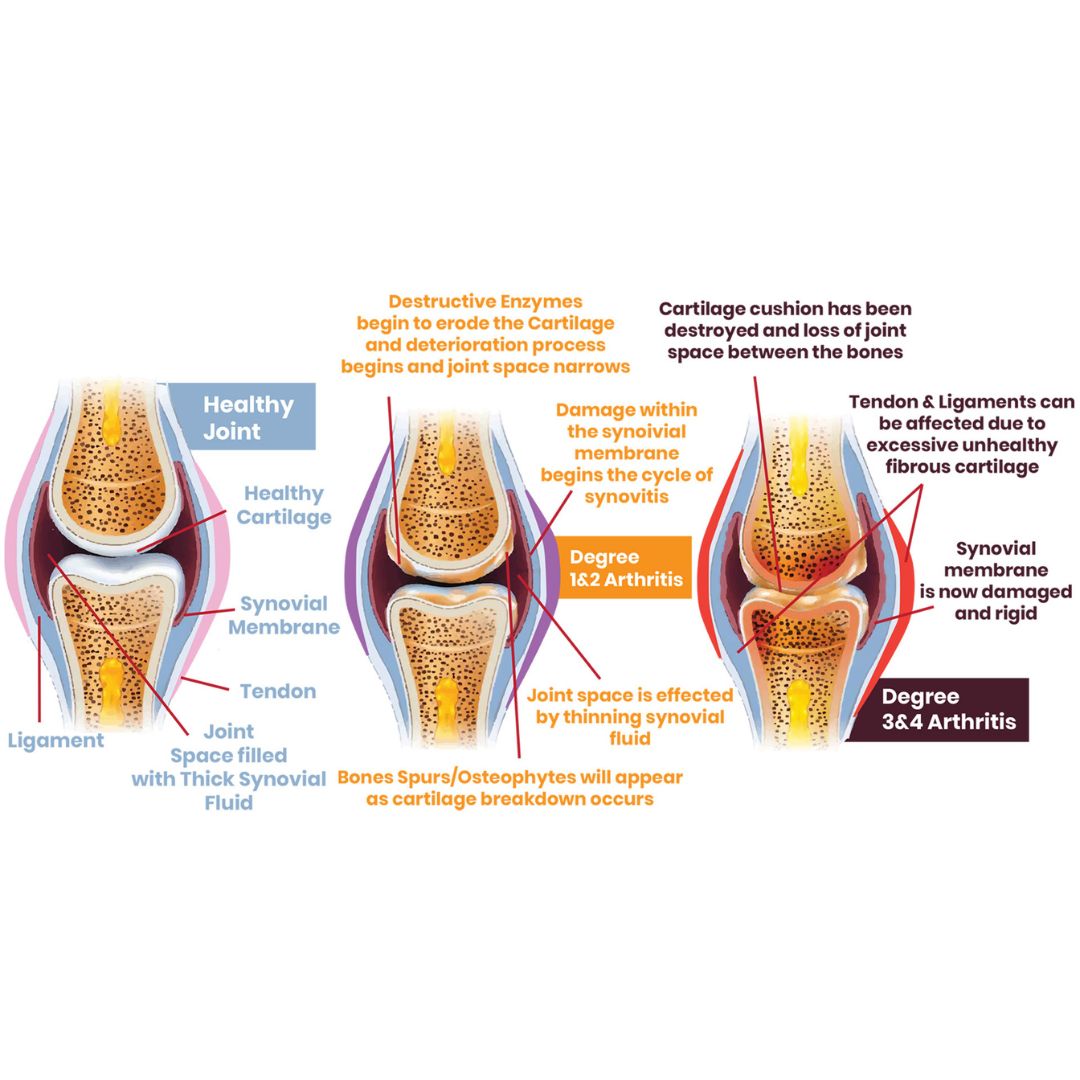Arthritis is one of the most common chronic conditions affecting dogs, particularly as they age. This degenerative joint disease can cause persistent pain, stiffness, and reduced mobility, significantly impacting a dog's overall quality of life. By understanding the causes, symptoms, and treatment options available, dog owners can take proactive steps to help manage and alleviate their pet’s discomfort, ensuring they stay active and happy for as long as possible.
What is Arthritis in Dogs?
Arthritis, also known as osteoarthritis (OA) or degenerative joint disease (DJD), is a progressive deterioration of joint cartilage. Cartilage acts as a cushion between bones, allowing smooth movement. When cartilage breaks down due to wear and tear, bones rub together, leading to inflammation, pain, and stiffness. Though arthritis cannot be cured, proper treatment and lifestyle modifications can significantly improve a dog's comfort and mobility.
Common Causes of Arthritis in Dogs
Several factors contribute to the development of arthritis, including:
- Aging: As dogs grow older, their joints naturally wear down, increasing the risk of arthritis.
- Previous Injuries: Ligament tears (such as cranial cruciate ligament injuries), fractures, and dislocations can lead to long-term joint damage and arthritis.
- Breed Predisposition: Larger breeds, including Labrador Retrievers, German Shepherds, and Golden Retrievers, are more susceptible to arthritis due to their size and genetic joint structures.
- Obesity: Excess weight puts significant strain on joints, accelerating cartilage deterioration.
- Hip and Elbow Dysplasia: These genetic joint abnormalities often lead to early-onset arthritis.
- Inflammatory Joint Conditions: Autoimmune diseases and infections can cause or worsen arthritis by triggering chronic inflammation.
Early Signs and Symptoms of Arthritis in Dogs
Identifying arthritis symptoms early can help in timely intervention and better management. Look for:
- Limping or Lameness: Dogs may favor one leg, especially after resting.
- Stiffness, Especially in the Morning: Difficulty standing up or moving after lying down.
- Decreased Activity Levels: A once-active dog may hesitate to run, jump, or play.
- Difficulty Climbing Stairs or Getting in Cars: These actions require flexibility and strong joints, which become compromised.
- Swollen or Painful Joints: Inflamed joints may appear swollen or warm to the touch.
- Behavioral Changes: Increased irritability, anxiety, or depression due to chronic discomfort.
- Excessive Licking or Chewing at Joints: Dogs instinctively try to soothe painful areas by licking or biting.
If your dog exhibits any of these symptoms, a veterinary consultation is necessary for proper diagnosis and treatment.
Diagnosing Arthritis in Dogs
Veterinarians diagnose arthritis using:
- Physical Exams - Checking for joint pain, stiffness, and mobility restrictions.
- X-Rays and Imaging - Detecting bone degeneration, cartilage loss, and joint inflammation.
- Joint Fluid Analysis - Identifying infections or autoimmune diseases affecting the joints.
- Blood Tests - Ruling out underlying conditions that may contribute to joint issues.

Best Treatment Options for Arthritis in Dogs
There are several approaches to treating arthritis, depending on the severity and the dog's size, age, and activity level.
1. Weight Management to Reduce Joint Stress
Maintaining a healthy weight is one of the most effective ways to slow arthritis progression. Overweight dogs experience more joint stress, worsening inflammation and discomfort. Implementing a nutritionally balanced diet and portion control is essential.
2. Low-Impact Exercise & Physical Therapy
Regular, controlled exercise keeps joints mobile and muscles strong without putting excessive strain on them. Activities like:
- Swimming: Low-impact, effective for joint strengthening.
- Leash Walking: Helps maintain movement without excessive stress.
- Hydrotherapy: Supports joint flexibility and reduces pain.
3. Medications for Pain and Inflammation
For managing pain and inflammation, veterinarians may recommend:
- NSAIDs (Non-Steroidal Anti-Inflammatory Drugs): Commonly prescribed to reduce pain and inflammation.
- Pain Relievers: Tramadol and gabapentin help manage chronic discomfort.
- Corticosteroids: In severe cases, these powerful anti-inflammatories can provide relief.
4. Joint Supplements for Long-Term Support
OptiWize can significantly help dogs suffering from arthritis by supporting joint health and reducing inflammation. The blend of ingredients like glucosamine, chondroitin, MSM, and omega-3 fatty acids works together to repair cartilage, reduce pain, and improve joint lubrication. The supplement's anti-inflammatory properties help reduce the swelling and discomfort associated with arthritis, allowing dogs to regain mobility and move more comfortably. Hyaluronic acid and green-lipped mussel enhance joint flexibility, while vitamin C and manganese support tissue repair. Regular use of OptiWize helps manage arthritis symptoms, offering dogs better quality of life and improved movement.
5. Alternative Therapies for Arthritis Management
Alternative therapies can complement traditional treatments:
- Acupuncture: Stimulates blood circulation and promotes healing.
- Cold Laser Therapy: Non-invasive treatment that reduces pain and inflammation.
- Stem Cell Therapy & PRP (Platelet-Rich Plasma): Regenerative treatments showing promising results in joint repair.
6. Surgery for Advanced Arthritis Cases
For dogs with severe arthritis, surgical options may be necessary:
- Total Hip Replacement: Restores full mobility in dogs with severe hip arthritis.
- Arthroscopy: A minimally invasive procedure to remove damaged cartilage.
- Arthrodesis (Joint Fusion): Eliminates movement in severely damaged joints to reduce pain.
How OptiWize Can Help Manage Arthritis in Dogs
OptiWize is a scientifically garantie for arthritis in dogs, but with proper management, pain relief strategies, and lifestyle adjustments, your dog can enjoy a happy and active life. Using a combination of diet, exercise, supplements, and veterinary treatments, pet owners can effectively manage arthritis and provide their furry companions with the comfort they deserve.
Find out more about OptiWize for Dogs
Research
1. "Advances in the Pharmaceutical Treatment Options for Canine Osteoarthritis"
Authors: McGowan, C. M., et al.
Published in: 2022
Summary: This review examines current pharmaceutical treatments for canine OA, including non-steroidal anti-inflammatory drugs (NSAIDs), monoclonal antibodies, and regenerative therapies.
Link: PMC
2. "Could it be Osteoarthritis? How Dog Owners and Veterinary Surgeons Recognize and Manage Canine OA"
Authors: Adams, C., et al.
Published in: 2020
Summary: This study explores the perspectives of dog owners and veterinary surgeons on recognizing and managing OA, highlighting communication challenges and trust issues in the veterinary setting.
Link: PMC
3. "Prevalence, Duration, and Risk Factors for Appendicular Osteoarthritis in Dogs Under Primary Veterinary Care in the UK"
Authors: O'Neill, D. G., et al.
Published in: 2018
Summary: Utilizing data from the VetCompass™ program, this research investigates the prevalence and risk factors associated with appendicular OA in dogs under primary veterinary care in the UK.
Link: Nature
4. "Improvement of Arthritic Signs in Dogs Fed Green-Lipped Mussel Powder"
Authors: McLennan, S. R., et al.
Published in: The Journal of Nutrition, 2022
Summary: This study evaluates the effects of green-lipped mussel powder supplementation on arthritic signs in dogs, demonstrating significant improvements in joint health.
Link: The Journal of Nutrition
5. "Pentosan Polysulfate in the Treatment of Osteoarthritis in Dogs"
Authors: Read, R. A., et al.
Published in: 1996
Summary: This research assesses the efficacy of pentosan polysulfate sodium in treating OA in dogs, highlighting improvements in clinical signs and joint health.
Link: Wikipedia
These articles provide valuable insights into the understanding, recognition, prevalence, and management of arthritis in dogs, offering evidence-based information for both veterinary professionals and pet owners.



